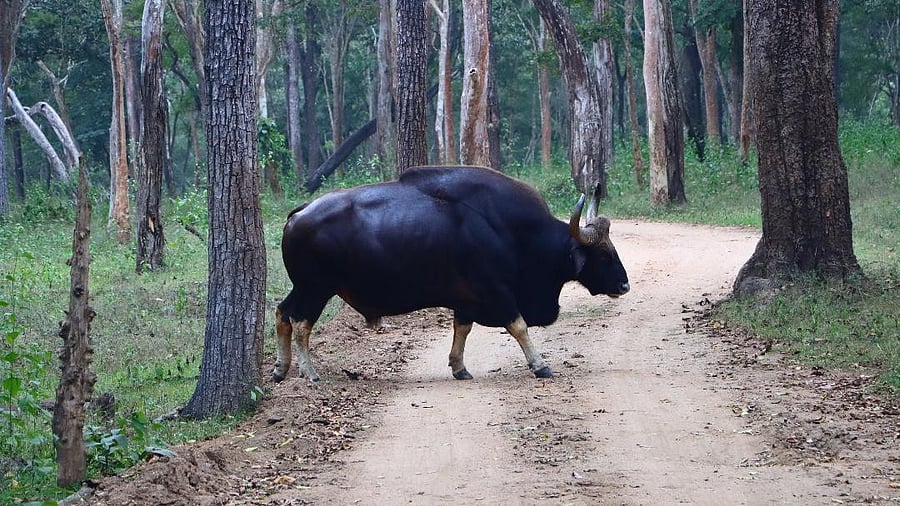
Indian gaur.
Photos by author
The Kabini river, a beautiful waterway winding through the Western Ghats, shares its name with an equally breathtaking forest in Karnataka. The Kabini Wildlife Sanctuary, also known as Nagarhole National Park, is part of the larger Nilgiri Biosphere Reserve. British viceroys and Mysore royalty (it was the exclusive hunting reserve of the Wadiyar kings) frequented this pristine jungle in search of big game.
Today, it is a popular destination for nature enthusiasts and wildlife lovers. The dilapidated royal guest house at the wildlife sanctuary, where the rulers once stayed during their hunting expeditions, is a testament to a bygone era.
Established in 1955, the Kabini Wildlife Sanctuary was upgraded into a national park in 1988 and declared a tiger reserve in 1999. The park’s area, which was 258 square kilometres initially, now covers over 840 square kilometres.
The Kabini river, a natural boundary for the sanctuary, is a vital water source for the diverse wildlife inhabiting the area. Its presence ensures the sanctuary is a thriving ecosystem, supporting a wide range of flora and fauna.
Plethora of wildlife
The Kabini Wildlife Sanctuary, a key part of the Project Tiger initiative, is home to endangered apex predators, including tigers and leopards. The sanctuary’s impressive population density of 12 tigers per 100 square kilometres evidences the success of the project here.
The most fascinating part of our safari here was watching a majestic tiger saunter past our jeeps, utterly oblivious to our presence. The leopard, though, was elusive.
Also common to the landscape are dholes or wild dogs. They live in packs with over 20 members and maintain strong social bonds. Although only the size of an average mongrel, they are fierce predators, coordinating attacks to take down larger prey. Unfortunately, their numbers have dropped significantly. Hunting, particularly during the colonial era, is the main reason for the dramatic drop in dhole numbers. Dholes are still listed as endangered.
Nagarhole is also a birding paradise, with a plethora of bird species. Pack your binoculars and camera, and you will be ready for amazing avian adventures.
We saw large herds of Asian elephants roaming through the lush forests. With ample food, water, and a flat landscape, the sanctuary is ideal for these gentle giants to thrive.
Of the 50 tiger reserves in India, this sanctuary has the most elephants per unit area. Recent estimates indicate the park is home to about 1,000 elephants. The elephants once instilled fear in the hearts of villagers near the forest. Innovative approaches like track fencing are helping to minimise conflicts between humans and animals.
Sloth bears, barking deer, Malabar giant squirrels, porcupines, stripe-necked and ruddy mongooses, sambar, Indian wild gaurs, wild boars, grey langurs, bonnet macaques, crocodiles and pangolins are some of the other animals that call this park home. Beautiful, exotic butterflies add to the park’s magical and immersive wildlife experience.
Community engagement
The sanctuary’s success in implementing several conservation measures to safeguard the carnivores and elephants is a beacon of hope. These measures, including strict anti-poaching patrols, habitat restoration and community engagement programmes, combat the severe threat of illegal hunting in the Western Ghats. They offer a glimmer of hope for the survival of these endangered species.
The safari in Nagarhole gave us valuable insights. The guides shared captivating information about the warning calls sounded by birds and animals. We also learned about tiger and leopard paw prints, and the deep territorial markings these big cats leave on tree trunks.
One thing is for certain: This place will captivate you!